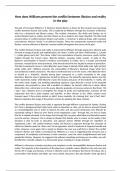How does Williams present the conflict between illusion and reality
in the play
The plot of Tennesee Williams’s ‘A Streetcar Named Desire’ is driven by the constant and unceasing
conflict between illusion and reality. This is explored by Williams through the character of Blanche,
who has a delusional and illusory nature. The realistic characters, like Stella and Stanley, try to
anchor Blanche back to reality, but their failure to do so leads to her tragic downfall. The title itself
presents ideas of conflict between illusion and reality; a ‘streetcar’ is physical thing, with mundane
concreteness, whereas ‘desire’ is an abstract impulse. These two components represent reality and
illusion, and are reflective of Blanche’s mental conflict throughout the course of the play.
The conflict between fantasy and reality is expressed by Williams through appearance. Blanche puts
forward an image of purity and sophistication; she wears ‘a white suit with a fluffy bodice […] pearls
[…] white gloves and a hat’. The colour ‘white’ has connotations of purity, innocence, youth, further
implied through her French name, ‘Blanche Dubois’, meaning ‘white woods’. In spite of this,
Blanche’s presentation of herself is fictitious and falsified; in reality, she is a chaotic and twisted
character, warped by her own grievances, who shrouds herself in her façade by means of protection.
This idea is exposed in Scene 5, when Blanche’s pure image is tainted; Stella spills coke ‘right on [her]
pretty white skirt’: Williams presents the vulnerability of Blanche’s illusional image while she’s
surrounded by realistic characters. This idea is reinforced later on in the scene, when Blanche refers
to herself as a ‘butterfly’, despite having been compared to a moth constantly in the stage
directions. Blanche aims to glamourise herself by doing so; the butterfly represents illusion and the
moth represents reality: while Blanche craves the beauty and grace of the butterfly, in reality, she
the moth; weak, fragile, and awaiting impending exposure. Upon Blanche’s arrival at the Kowalski
apartment, she proceeds to ‘pour half a tumbler of whiskey’ for herself, while she is alone. When
Stella offers her a drink later on in the scene, Blanche pretends not to know where to find them: ‘Oh
I spy! I spy!’. Blanche aims to strengthen her image of purity and sophistication, and give off the
impression that she is both modest and lady-like. In New Orleans in the 1940s, women were
frowned upon if they drank alcohol or didn’t dress modestly. By claiming that ‘one’s [her] limit’,
Blanche replicates this image of the perfect woman by adopting this false modesty.
The conflict between illusion and reality is apparent through Williams’s portrayal of Stanley. Stanley
isn’t from a background that holds much value in education or class, yet he tries to present himself
as a knowledgeable man in order to impress his wife, and also assert dominance over Blanche by
repeatedly asking if ‘[they’ve] ever heard of the Napoleonic code’. Through this, he tries to imply
that he is indeed educated, in the hopes that through this, he gains admiration and therefore power
over the women. However, this is simply an illusion that Stanley aims to create, as the reality of the
situation is that he lacks in education, and appears almost childish through his repetition of
‘Napoleonic code’. The conflict between reality and illusion is apparent through the character of
Mitch too. Blanche spots his ‘silver case’ for his cigarettes, which is implicant of supposed wealth and
riches. However, once again, this is simply an illusion; the case was a gift from a friend. The conflict
between illusion and reality is introduced by Williams as a way of suggesting that everyone has a
component of complexity and fantasy to their character, even the most straightforward and basic
people like Stanley. However, he suggests that without something anchoring you to reality, you will,
like Blanche, mentally collapse in a downwards spiral, resulting in a tragic downfall.
Williams’s references to books and plays puts emphasis on the incompatibility between illusion and
reality. The majority of the characters of the play have a realistic nature; Blanche is the only one who
thrives off of magic and fantasy. In Scene 5, Blanche starts to introduce the theme of fantasy into a
conversation with Stanley and Stella, two very realistic characters. She asks Stanley ‘what sign [he’s]




